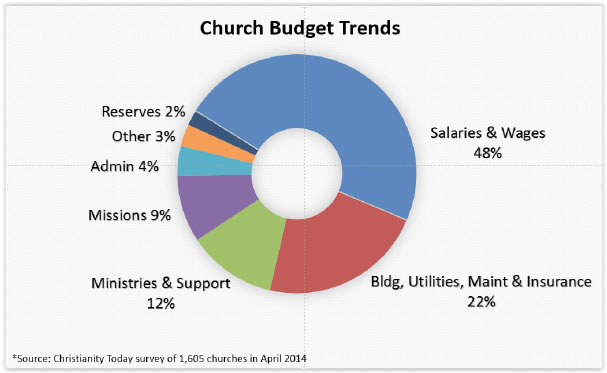
Appropriate Budget Percentages for Church Expenses
By Rollie Dimos | Church Budgeting & Finances
What are appropriate budget percentages for our church? This is a common question that arises every time a church budget is created. Unfortunately, there is no clear-cut answer.
What one church spends on personnel costs shouldn’t dictate what another church can spend (or afford) in personnel costs. What each church spends will depend on the unique circumstances of each church, and these budget percentages are certainly influenced by the strategic vision of the church and other socio-economic factors in and around the church. While churches have many things in common, no one church is like another. Churches will vary in revenue, staffing, infrastructure, ministry programs, and debt, which makes it difficult to make a generalized statement about how much of the church’s budget should be allocated to certain functions in the church.
One lending institution stated that in order to provide a loan to a church, they require that debt and salaries should be no more than 70% of undesignated tithes and offerings. This allows 30% for operations and ministry programs.
Other churches ascribe to the 33/33/33 model: 33% is allocated to salaries, 33% is allocated to operations/programs, and 33% is allocated to building and infrastructure.
However, this cookie-cutter approach doesn’t fit all churches.
For example, a new church plant may have to rely on volunteers and a bi-vocational pastor to fill key roles in the church. This young church may have lower personnel costs, but expend a larger percentage of the budget for facility rental and outreach. On the other hand, a church that has no building debt may be able to spend more on staffing and may incur personnel costs that exceed 50% of its budget.
In April 2014, Christianity Today surveyed 1,605 churches and identified budget trends. The following chart identifies the average budget percentages in key functions at these churches.
These percentages are not meant to be prescriptive, but comparing your church activity to these averages may be helpful or insightful.
Here are some additional ideas to consider as you develop and review your budget:
- Seek counsel within your network of pastors who may be in a similar sized church or face similar socio-economic factors. Even if your church doesn’t fit precisely into the same model as another church, the comparison of where your church is on staffing levels, debt, facility expenses, number of individuals being served, etc., can be extremely valuable in helping you establish an appropriate budget for your church.
- Consider your mission and vision for the church. Create a budget that reflects those priorities. For example, if the church has a vision to reach young families, more funds may be allocated to developing family-friendly environments, programs, and outreach opportunities.
- Consult experienced members within your church for help. Find businessmen and -women within your church who create and execute budgets as part of their daily job. They will have expertise that will be invaluable to you.
- Lastly, the IRS requires compensation provided to ministers to be reasonable. As you create your budget and review compensation packages, one way to determine reasonableness is to consult independent compensation surveys for comparison. Christianity Today has a great compensation tool for churches. You can find that at churchsalary.com.
The Southern Baptist Convention also publishes a compensation survey that is freely available on their website.
 ASSEMBLIES OF GOD
ASSEMBLIES OF GOD
